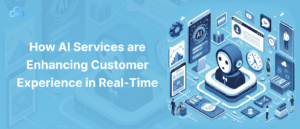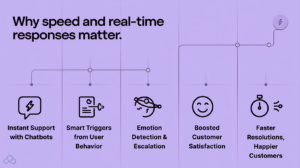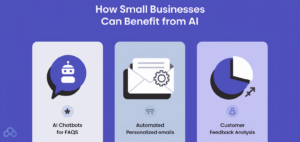How AI Services Are Enhancing Customer Experience in Real Time

In today’s time people expect more than just good products. They want fast and personalized service. Meeting these expectations is not a cup of tea, especially for businesses that interact with customers across various channels. This is where AI services for customer experience comes in. These tools are changing the picture, helping businesses respond quickly, customized services, and solve problems faster than ever before.
Real-Time Support Through AI
AI is changing the way companies interact with their customers. From responding to questions in seconds to recommending products a customer is likely to love, AI helps businesses offer smoother, more satisfying experiences. All of this happens in real time, which is why AI is becoming essential for customer service. In this blog, we will explore how companies are using real-time AI solutions, the benefits of these tools, and how they’re changing the future of customer experience.
What Are AI Services for Customer Experience?
AI services for customer experience refer to the technologies and tools powered by artificial intelligence that allow businesses to better understand, connect with, and support their customers. These services use a combination of data, algorithms, and machine learning to make every interaction more efficient, accurate, and personal. Instead of thinking about what a customer might need, these tools learn from past behaviors and offer solutions based on actual data.
Everyday Examples of AI in Customer Experience
Examples of AI in customer experience are everywhere. Chatbots and virtual assistants are now common on websites and apps, offering instant help. AI-driven product recommendations suggest what customers might like based on their browsing or purchase history. Sentiment analysis helps brands understand how customers feel, while personalized emails or website content make customers feel understood. Voice assistants and automated phone systems also work on AI to serve customers.
Why Speed and Real-Time Responses Matter

What makes real-time AI solutions amazing is speed. In today’s fast-moving digital world, customers expect quick responses. Whether it’s a product question, a complaint, or help placing an order, no one wants to wait. Real-time AI steps in to meet this demand.
For example, a chatbot can respond instantly instead of making someone wait for a live agent. If someone keeps checking the return policy page, AI can automatically offer help. If frustration is detected in a customer’s message, AI can escalate the issue to a human agent. All of these actions increase satisfaction and keep customers coming back.
How AI-Driven CX Improves Customer Experience
The benefits of AI-driven customer experience are many . First, it shortens response times magically. Customers get answers when they need them, not hours later. This makes a big difference in how customers perceive a brand. Second, AI helps personalize interactions. AI personalization tools use data like past purchases or browsing behavior to suggest the right products or send targeted emails. Third, AI scales easily. Unlike human agents who can handle only a few customers at a time, AI tools can serve thousands at once without delays.
Consistency is another big plus. AI delivers the same quality of service every time, without the risk of fatigue or error that can affect human performance. It’s also available 24/7, giving customers access to help whenever they need it day or night. Another smart feature is predictive assistance. AI can often guess what a customer needs based on their actions. And finally, using AI can cut costs for businesses, reducing the need for large support teams without sacrificing service quality.
Case Study: Netflix and Hyper-Personalized Viewing
Another example of AI enhancing customer experience in today’s world is Netflix. The streaming platform depends on AI and machine learning to power one of the most advanced recommendation engines in the world. Every time a user interacts with Netflix by watching, rating, or browsing content the platform collects data points. These data points feed into complex algorithms that learn what each user likes, when they like to watch, and what they are most likely to enjoy next.
This AI engine doesn’t just recommend what’s trending or what’s new. It dives deeper, customizing everything from the homepage layout to the artwork used to display shows. For instance, if two users are both shown the same movie, one can see the action scenes featured in the cover image while the other sees a romantic subplot, based on their viewing history. This real-time content personalization helps Netflix retain subscribers and reduce decision fatigue.
Behind the scenes, Netflix’s AI constantly runs A/B tests on viewers to see what version of a thumbnail image, genre tag, or description works best. This insight allows Netflix to optimize the customer experience on a micro-level, helping each user feel like the platform understands their preferences. In turn, it improves viewing time and increases user satisfaction. Netflix also uses AI to forecast bandwidth demands, recommend titles based on regional popularity, and even greenlight content that’s likely to perform well with specific audience segments.
Case Study: Sephora’s Virtual Assistant
Sephora, of course female’s corner the beauty and cosmetics retailer, offers another real-time AI experience that has reshaped customer service. The company’s virtual assistant, available through its app and website, provides personalized product recommendations based on a customer’s skin tone, preferences, and prior purchases. Users can take quizzes and upload photos, and the AI uses this information to match them with the best foundation shade or skincare solution.
What sets Sephora apart is how smooth and conversational the experience feels. Instead of navigating a cluttered website, users get curated results and expert advice delivered in seconds. This AI-powered service doesn’t just answer questions, it acts like a beauty consultant available 24/7. In stores, Sephora also uses AI-enabled devices like Color IQ to help shoppers find the perfect match by scanning their skin tone.
These tools have helped Sephora bridge the gap between physical and digital experiences, making their omnichannel approach more connected. Customers can start a consultation online, visit a store for testing, and then receive follow-up recommendations all thanks to a unified AI system that remembers their preferences and interactions.
Case Study: American Express and Predictive Customer Service
American Express (AmEx) yes you heard right, people started obsessing over after watching Luck Bhaskar movie uses AI to detect fraud, enhance security, and deliver proactive customer service. Their AI system analyzes thousands of transactions in real time to identify suspicious behavior. For example, if a customer suddenly makes a large purchase in another country, AI instantly checks it against known patterns. If it looks unusual, the system may flag it, block it temporarily, or notify the cardholder instantly.
In addition to security, AmEx uses AI for predictive customer service. Based on previous spending behavior, life events, and seasonal trends, the platform anticipates what kind of assistance or product a customer may need. If someone is consistently booking travel or shopping internationally, they might get offers for travel insurance or foreign exchange benefits.
This proactive, AI-driven CX allows AmEx to build trust, reduce risk, and offer services customers didn’t even know they needed. The real-time responses and personalized support reflect a deep understanding of customer behavior, helping to boost satisfaction and loyalty.
These case studies: Starbucks, Netflix, Sephora, and American Express demonstrate how real-time AI is being used across industries to create better customer experiences. Whether it’s customizing content, providing virtual consultations, or protecting against fraud, the role of AI is to serve customers faster, smarter, and in ways that feel intuitive and personal.
Case Study: Starbucks and AI-Powered Personalization
One amazing example of how AI upgraded customer experience in real time is Starbucks. The global coffee chain has leveraged AI technology not just to personalize interactions, but also to anticipate customer needs before they even place an order. Starbucks’ AI-driven initiative, known as “Deep Brew,” uses machine learning and real-time data to power personalized marketing messages, optimize store operations, and tailor recommendations to individual customers.
When a customer opens the Starbucks mobile app, AI immediately begins analyzing multiple factors. It looks at the customer’s purchase history, time of day, local weather conditions, and even location data. Based on these variables, it offers a tailored suggestion, like a hot pumpkin spice latte on a rainy morning or a cold brew on a warm afternoon. This real-time personalization creates a seamless, enjoyable experience that feels thoughtful and relevant to each customer.
Behind the scenes, Deep Brew constantly learns from millions of interactions, improving the accuracy of its suggestions over time. This not only boosts customer satisfaction but also increases average order value and drives app engagement. The system also helps with store-level operations. It can predict demand trends by location and help staff plan inventory and shifts more effectively. This means customers get their favorite drinks faster and with fewer mistakes, even during busy hours.
The impact of this AI-driven customer experience strategy is clear. Starbucks has seen an increase in customer engagement through its loyalty app, higher redemption of personalized offers, and more consistent repeat visits. The technology allows Starbucks to maintain a high level of personalized service at scale something that would be extremely difficult using only human staff.
The success of Starbucks tells how AI services for customer experience can work in real time to drive both customer happiness and business performance. By integrating AI into both its app and store operations, Starbucks offers a model for how companies can blend smart technology with human service to create memorable customer experiences.
This kind of AI-driven CX isn’t limited to massive brands. Many of the same tools used by Starbucks- recommendation engines, predictive analytics, and personalized messaging are available in simpler forms to small and medium-sized businesses through third-party platforms. The Starbucks case proves that when done right, AI doesn’t just support the customer journey, it enhances it at every step.
In real-world, many companies are already using AI to enhance customer experience. Amazon uses AI in almost every part of its service from recommending products to predicting delivery times. Alexa, Amazon’s voice assistant, also helps users interact with services quickly. Netflix is another great example. It uses AI to study viewing patterns and suggest shows or movies each user is most likely to enjoy.
Starbucks uses AI in its app to offer deals that match your buying habits and location. Meanwhile, Sephora’s chatbot helps users find makeup products based on skin type and preferences, and even provides tutorials. These examples show how AI tools are already a core part of everyday customer experiences.
Technologies Powering AI-Driven CX
Behind these smart services are powerful technologies. Natural Language Processing (NLP) allows machines to understand and reply in human language. Machine learning lets systems improve with each interaction. Predictive analytics helps forecast customer actions, while sentiment analysis picks up on customer emotions. Recommendation engines do the heavy lifting in suggesting the right content or products. Together, these tools form the foundation of modern, AI-driven CX.
Challenges of Using AI in Customer Experience
Despite its advantages, there are still challenges to using AI in customer service. Data privacy is a big concern. Customers want to know how their data is being used and expect companies to protect it. Transparency and compliance with privacy laws are essential. Another issue is the lack of human touch. AI may be efficient, but for emotional or complex problems, people often want to talk to a real person. Also, building and maintaining AI systems isn’t cheap. They require investment in technology and talent, which can be hard for smaller businesses. Regular updates are needed to ensure accuracy and effectiveness over time.
How Small Businesses Can Benefit from AI

Still, the benefits usually outweigh the downsides especially when AI supports, rather than replaces, human agents. Small businesses, in particular, can take advantage of AI with easy-to-use tools. Many services offer ready-made AI solutions that don’t require technical skills or large budgets. A small business might use a chatbot to answer FAQs, send automated personalized emails, or analyze customer feedback to improve services. Starting small and growing gradually is a smart strategy.
The Future of AI in Customer Experience
Going forward, AI will play an even bigger role in shaping customer experiences. Future tools will offer even more human-like personalization, stronger integration with voice and video, and smarter responses to complex queries. Rather than replacing humans, AI will work alongside them, boosting productivity, speed, and consistency. AI will shift from being just a tool to becoming a helpful teammate, quietly improving every step of the customer journey.
Conclusion
In conclusion, AI services for customer experience are helping businesses build deeper, faster, and more meaningful relationships with their customers. Real-time AI solutions and personalization tools are changing the way support works from instant answers to smart recommendations. Whether you run a large company or a small shop, embracing AI in customer service can lead to happier customers, lower costs, and stronger brand loyalty.
If your business is ready to improve its customer service, now is the time to explore AI solutions that fit your needs.
Do you like to read more educational content? Read our blogs at Cloudastra Technologies or contact us for business enquiry at Cloudastra Contact Us